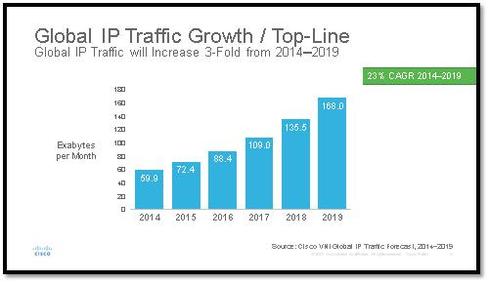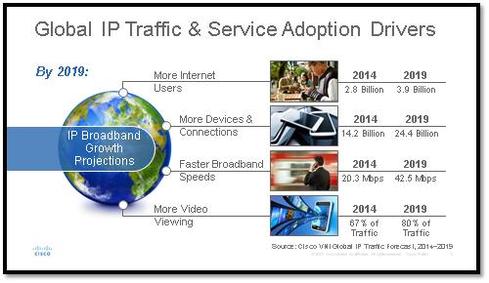More Internet users, more connected devices, faster broadband speeds and more video all add up to one thing: a heck of a lot of IP traffic. Cisco's latest Visual Networking Index (VNI) shows global Internet traffic growing at an eye-popping rate, reaching 2 zettabytes per year by 2019.
Two zettabytes is 12 times more than all the IP traffic generated in 2009, according to Cisco.
While it took 32 years -- from 1984 to 2016 -- to reach the first zettabyte mark, it will take only three more years to reach 2 zettabytes, Cisco Senior Analyst Arielle Sumits said in an interview. "The volumes are mind-boggling," she said.
Global IP traffic will grow at a compound annual growth rate of 23% between 2014 and 2019, reaching 168 exabytes per month in four years, according to the 10th annual Cisco VNI forecast.
The number of Internet users worldwide will leap from 2.8 billion last year to 3.9 billion by 2019, with the Middle East and Asia showing the biggest increases in Internet users. The number of connected devices will surge to 24.4 billion in four years, including laptops, tablets, smartphones, wearables and M2M technologies. The number of networked devices or connections will increase to 3.2 per capita, up from 2 per capita in 2014.
The average fixed broadband speed will more than double from 20.3 Mbps in 2014 to 42.5 Mbps in 2019, Cisco predicts.
Mobile traffic will grow at a faster rate than fixed traffic, Sumits said. Cisco expects 53% of global Internet traffic will come from WiFi connections and 14% will come from cellular connections in four years.
The Internet of Things, or the Internet of Everything as Cisco calls it, will show marked growth with M2M connections tripling by 2019 to 10.5 billion, according to the VNI report. M2M modules will make up 43% of total global devices and connections. The connected home, including smart appliances, home security and network devices such as printers will make up nearly half of the M2M connections in 2019.
The proliferation of devices and connections will put pressure on service providers to adopt IPv6, according to Cisco. In fact, by 2019, 41% of networked devices globally will be IPv6 capable, up from 22% in 2014.
IPv6 traffic will represent 34% of total Internet traffic in four years, with the most growth coming from Asia Pacific and North America. Cisco forecasts that 25% of global Internet content will be IPv6 enabled.










